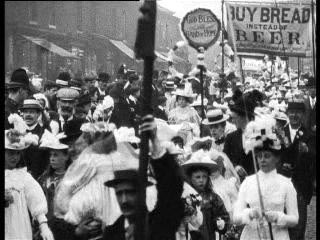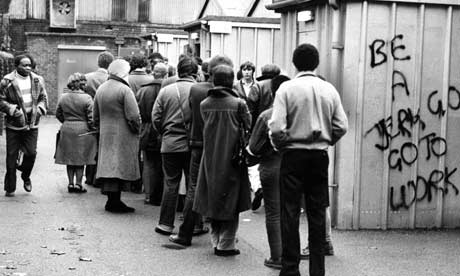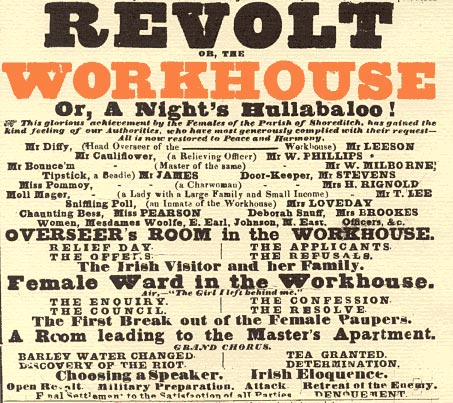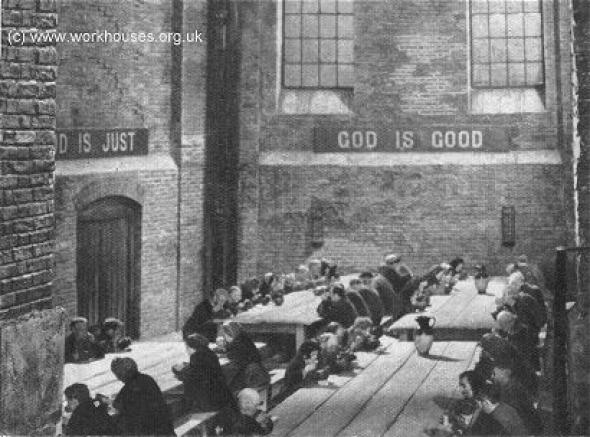Lies and Mendicity
The spectre of poverty has always been used by the powerful as a stick to goad those wishing to live without working. Here Demetra Kotouza explores the intimate relationship between the management of the pauper and the (re)production of the labourer, overseen by state and philanthropic institutions. Whether stigmatised by the workhouse, cushioned by welfare or patronised by the neoliberal rhetoric of self-help, she argues, the poor are a necessary constant of capitalism
The commonly made observation that neoliberalism represents a return to the Victorian era, though sometimes betraying a nostalgia for social democracy, nevertheless has an empirical credibility. Similarities between Adam Smith and Milton Friedman, the workhouse and workfare, slum clearance and regeneration, the recruitment of working class missionaries by philanthropists and of ‘social entrepreneurs’ by contemporary charities, all bear witness to the continued relevance, if not ‘return’, of Victorian practices. Rather than an atavistic reversion to an outdated system of economy and governance, however, such parallels reveal the persistence of a problem faced by capital and the state: that of the production, management and moulding of propertyless populations in the most profitable way. Shifts in the administration of poor relief in early 19th century Britain, and subsequent philanthropic interventions, bear a resemblance to changes taking place today. Beyond a mere analogy, this entails an actual reappearance of private charity in the management of poverty, its Victorian inspiration explicitly acknowledged by ideologists and politicians for charity’s supposed capacity to become the ‘other invisible hand’ that can eliminate ‘social exclusion’. An examination of such changes shows that history is not merely repeating itself, but rather that these policies, techniques and practices, no matter how crude, subtly invasive or seemingly benign, have never been separable from capital’s need to reproduce itself.
The first quarter of the 19th century revealed the inability of the centuries-old parish poor relief system to cope with the degree of poverty and mass flight of dispossessed peasants to the cities entailed by enclosures, mechanisation and the monetarisation of labour. ‘Old’ Poor Laws were held responsible, in the 1833 Poor Law Commissioners’ report, for a demoralisation in the labouring classes that not only disturbed labour market equilibrium but also caused social unrest. The old Poor Laws were a check to industry, a reward for improvident marriages, a stimulant to population, and a blind to its effects on wages; a national institution for discountenancing the industrious and honest, and for protecting the idle, the improvident and the vicious; the destroyer of the bonds of family life; a system for preventing the accumulation of capital, for destroying that which exists, and for reducing the rate-payer to pauperism; and a premium for illegitimate children in the provision of aliment.[1]
The 1834 Poor Law Amendment Act was designed to convert ‘paupers’ into ‘independent labourers’ by making relief conditional upon entering a workhouse where conditions would be so unbearable as to deter everyone but the most destitute and infirm. Although some 2000 workhouses were already in operation by the late 18th century, these institutions were managed locally, and had mostly ended up functioning as geriatric wards and orphanages with a parallel system of outdoor relief for the ‘able bodied’. The new law reinstated and standardised their disciplinary function by banning outdoor relief and transferring ultimate control to the state. Inspired by Malthusian prescriptions on restraining the number of ‘supernumerary’ populations and Benthamite notions of rewards and punishments, the liberal government was not merely interested in unconditionally fostering the population. It had to achieve ‘security and prosperity for the greatest number’ in the most cost-effective way, meaning that it would no longer give ‘legal status to inferiority’.[2] The survival of such inferiority was then to be excluded from legal providence, while its continued existence was necessary for the maximisation of ‘independent labour’.
Workhouses were to be institutional spaces of extreme poverty; but with life outside often already below subsistence levels, and since inmates had to be kept alive, a harsh disciplinary regime was imposed to frighten away everyone who had the slightest prospect of life. Those desperate enough to enter the ‘Poor Law Bastilles’ were segregated into yards to prevent procreation or the corruption of children by their parents, and were subjected to the penal labour of breaking stones and picking oakum.[3] While not prescribed by the Law, the forms of violence routinely inflicted on inmates included long-term incarceration, withholding food, neglecting severe wounds and illnesses, placement of the sane in insane sections, and rape. These punishments were often fatal. A series of cases publicised by workhouse inspectors shocked the bourgeois public with the ‘lawlessness’ that reigned in those spaces.[4] This lawlessness, however, had been instituted in the workhouse by the New Poor Law itself, with its implication that inmates did not deserve to live. As Engels observed, ‘[i]f the law in its essence proclaims the poor criminals, ... beyond the pale of the law, beyond the pale of humanity, objects of disgust and repulsion, then all commands to the contrary are unavailing’. Workhouse thanatopolitics may appear extreme and irrelevant to contemporary forms of workfare, but its legacy can be seen in the punitive nature of such schemes, where punishment is the strategic withdrawal of the means of subsistence.
The Malthusian fear of the uncontrollable geometrical increase of pauper populations could not just be alleviated by removing obstacles to premature mortality in the lower classes for the sake of the species survival. Preventive birth control measures were also needed which involved education outside the workhouses. The introduction of the New Poor Law then aptly coincided with a renaissance in a new type of philanthropic organisation which had rejected the idea of almsgiving, elaborating a variety of techniques by which to create a fit between political economy and the population. Charities, savings banks and friendly societies became crucial to the governmental aim of exerting influence over poor households in such matters as frugality and industry, foresight in marriage and reproduction, the education and discipline of children, hygiene, and philanthropic engagement. It is telling that the ‘voluntary impulse’ romanticised today by policy entrepreneurs such as Tristram Hunt and Geoff Mulgan did not condemn the institution of the workhouse, but rather wanted to expand the reach of its ‘reformative function’ to the private lives of poor families and individuals.
The Victorian philanthropists’ discourse on the poor was largely aligned with that of the liberal state. ‘Illegal’ workhouse violence was reproached, but much more worrying was the fact that despite that violence workhouses failed to act as deterrents. In 1846 the Charity Organisation Society (COS) – the most influential league of charities up to the 1880s – called for tighter controls in the acceptance of inmates and intervened to make sure that those who entered workhouses were truly ‘undeserving’. Officers of the COS and Octavia Hill visited poor households to investigate and reform home circumstances. Imperialist philanthropists proposed exporting the poor to the colonies (W. E. Stead) or transporting them to ‘labour colonies’ in the countryside (Charles Booth / The Salvation Army), where they would be taught the virtues of productivity without imposing their ugly and burdensome presence on respectable city dwellers. Even certain ‘socialist’ philanthropists such as Sidney and Beatrice Webb insisted that life that persisted ‘in disease and squalor, vice, mendicancy and crime’ was guilty of ‘infecting and contaminating the rest of the community’. The new wave of philanthropists sought to teach the working class how to reform itself on the assumption that poverty was the result of a series of individual or community produced moral failings. What those failings were is evident from the kind of middle class philanthropic societies that had emerged by 1897. Some examples from the Labour Annual: National Thrift Society; Ladies’ Sanitary Association; The Bible Women (working class women recruited by Ellen Ranyard to advise poor women on domestic economy and sell bibles); London Mendicity Society; National Anti-Gambling League; Band Of Hope (children committed to temperance); and Mary Carpenter’s Reformatory School in Bristol for the ‘children of the perishing and dangerous classes’. The liberal emphasis on individual responsibility, self-help and independence commanded that the ‘dangerous classes’ be controlled, managed and reconstructed because ‘the proletariat may strangle us unless we teach it the same virtues which have elevated other classes of society’.[5] With the 1870 Education Act, charities were given powers to found thousands of schools and enforce the attendance of children.
 Image: The Manchester Band of Hope on a temperance march in 1901
Image: The Manchester Band of Hope on a temperance march in 1901
In order to maximise the value of home visits and to guarantee consistency, societies also turned the poor into objects of research (e.g. Henry Mayhew, Charles Booth) and promoted the professionalisation of visitors through training and producing guidelines – practices which prefigured the institutions of social work and probation.
The fear that environmental degradation caused crime prompted street clean-ups and the construction of ‘model dwellings’ which was intended to displace slum residents rather than provide new housing. In the 1870s the solution to overcrowding and unsanitary habitation proposed by COS was compulsory purchase of slum areas and subsequent slum clearance by the Metropolitan Board of Works in London. It was hoped that demolition would disperse the ‘worst elements’ of the slum population, and when the new buildings were completed, only the respectable surrounding population would be attracted by their better quality and higher prices.[6] This strategy of displacement anticipates the current trend for creating new housing for ‘mixed communities’ in the place of previously run-down housing estates. Alongside these bourgeois philanthropic organisations, a number of socialist and working class associations had also appeared in the 19th century, whose ideology and activities were based on the principle of mutual aid. In the absence of welfare rights – which many of these organisations called for – self-help societies enabled the survival of low-paid labourers in times of hardship or in their old age, while often also becoming instruments for the self-imposition of discipline and bourgeois morality.
19th century charity’s ‘effectiveness’ in keeping the poor alive, ‘cultivating community’ and promoting ‘liberty, personal responsibility and independence’ are now lauded by neoliberal organisations such as the Institute of Economic Affairs (IEA) but also by New Labour think tanks such as Demos, as a morally and economically superior alternative to the welfare state. The similarity between 19th century narratives of the ‘root causes of poverty’ and their associated philanthropic and intellectual palliatives, and contemporary neoliberal and Third Way discourses on poverty and ‘social exclusion’ can be explained by the resurgent imperative to remove all alternatives to work and produce self-policing subjects. Inclusion requires everyone – those on incapacity benefit, pensioners, those in care – to rejoin the expanded workhouse: an institution that has never excluded anyone on the basis of age, physical ability, or mental state.
The Poor Law, nominally in place until 1929, was effectively superseded by the introduction of a basic social security system in 1912 which provided unemployment, sickness and maternity benefit. Prompted by the volume of unemployment and impoverishment generated by repeated crises of laissez-faire capitalism, and increasing working class pressure both directly and electorally, the British government was forced to make its first concessions, which were to be followed by the massive post-war expansion of the welfare system. The latter was part of an exercise in ‘Keynesian’ demand management aimed at generating full employment and enabling the working class to consume on a scale capable to sustain production and defuse class struggle. In this context, philanthropy had retained its policing role, with its investigative officers and retraining and reform centres still in operation, albeit at a smaller scale, providing expert knowledge on local ‘needs’, as the intellectual father of the British welfare state, Lord Beveridge, had suggested in his tract Voluntary Action. However, as the problem of poverty was mostly being managed by the state, and after the 1960 Charities Act which rationalised the supervision of charities and clarified their non-political mandate, charities were reduced to ‘covering gaps’ in welfare service, while trying to make inroads into the community, often antagonistic to labour organisations.[7]
Thatcher’s ‘80s government delivered the first great blow to state-guaranteed survival for the working class. This was not simply a return to the prerogatives of free markets, but rather a realisation that Keynesian state management had not only failed to create a social equilibrium that would allow markets to thrive, but actually become an impediment to labour markets. With trade unions divested of any power during the consecutive conservative governments in the ‘80s and early ‘90s, and with the end of the Cold War, the welfare state had become an unproductive and burdensome bureaucratic edifice, a leftover from the times of compromise.
 Image: A dole queue in Brixton in 1981. Photograph: Neil Libbert
Image: A dole queue in Brixton in 1981. Photograph: Neil Libbert
Thatcherism introduced renewed emphasis on voluntarism and ‘active citizenship’ with the 1988 Social Fund that was designed to bring charities closer to the state, and a tax reform to encourage donations. However, the proponents of civic capitalism such as IEA complained that ‘government with character’ and not laissez-faire should shape the policy of a truly liberal government, and this meant the active fostering of ‘civic virtues’, the individual responsibility ‘of free agents’ and ‘mutual obligation’ that had been eroded by the welfare state. What was needed was a return to ‘welfare without politics’, that is, Victorian-style private charity.[8] Worse, the conservative strategy of creating labour market competition and eliminating ‘lifestyle’ unemployment had been unsuccessful, as evidenced by the Poll Tax riots, anti-M11 protests and other upheavals. With New Labour, these ‘eroded values’ would be regenerated through ‘partnerships’ with ‘communities’ and the voluntary sector.
In 1992, before New Labour had come to power, Labour MP Frank Field’s statement already echoed 19th century fears about the uncontrollable classes, justifying the impending attack: ‘We’ve got a number of young people here who are outside the labour market, who’ve created their own world, partly through crime, partly through drugs, partly through drawing welfare, and who are not prepared to join Great Britain Ltd. again on the terms that we offer.’ The punitive New Deal for Young People and Communities was explicitly intended not only to revitalise the labour market by removing all other legal options for survival that strayed from the Gateway to Work, but also to innovate techniques for transforming behaviour. The ‘partnership’ with charities in the delivery of New Deal training placements was aimed at reducing costs, decentralising governance, and making use of charities’ ‘local knowledge, resources and experience’ in the management of working class youth.
The third sector fits easily into this role. These are officially ‘non-political’ organisations whose income is derived from middle class and corporate donors, the state and from unpaid labour. The appellation ‘non-profit’ does not indicate a lack of surplus, but its reinvestment in ‘good causes’: the production of the organisation’s service component of its commodity, which is distributed free or very cheaply. The full commodity, however, that which is sold for revenue and even profit, is the services provided to funders: ‘expertise, resources, and knowledge about local need’ for governmental funders; and the moral legitimation (and tax relief) of charity for private funders, together with the elimination/reformation of the most dangerous ‘pauper’ elements. In this sense, their ‘patients’’ active participation is necessary, and valorised in the production of the full commodity, while what they ‘get’ in return is effectively alms conditional upon appropriate conduct and on-the-job training.[9] The latter amounts to hyperexploitation by both the charity and the employer who often provides the training: trainees’ elusive reward is ‘skills’, i.e. a potential – unrealised and possibly unrealisable, ‘enhancement’ of their labour power. The charities’ function is therefore entirely political and economic, deliberately or inadvertently lending a friendly face to Third Way (neo)liberalism.
American academic Robert Putnam’s popular communitarian ideas also prescribe community ‘empowerment’ through voluntarism, aimed at promoting ‘social and political integration’, fostering ‘trust’ between and within classes, and promoting ‘socially productive norms’ – the ingredients for the creation of ‘social capital’.[10] Despite the spurious use of the word ‘capital’ to describe labour, this scenario is linked to policies intended to create profitable ‘community’ enterprise that would promote normative behaviour in ‘hard to reach’ ‘socially excluded’ populations. Local activists, specially selected for the values they champion (usually ‘peaceful integration’, ‘employment’, ‘independence’, ‘self-control’, ‘civic participation’), mostly targeting unemployed youth and adults, single mothers, black/ethnic groups, and people with ‘mental health’ problems, are nominated and funded as ‘social entrepreneurs’ on the condition that their projects will shortly become profitable. This productive moralisation of local life echoes 19th century projects: ‘life-skills training’ for the homeless (‘more than just a home’), self-help packages to be purchased by parents, savings and debt management education, self-confidence and self-reliance coaching, and good old work training most frequently in construction, cooking and carpentry. All this is combined with self-policing schemes such as ASBOs, and the charitable donation of broadband and ‘community TV’ where viewers can watch ‘familiar local faces’ as they commit crimes, and report them. This is not staged as a solely top-down dispositif of the state. Local Strategic Partnerships are all about selectively attending to demands made in the name of ‘the law-abiding, long-suffering poor’ or by more openly authoritarian ‘ordinary people’ who cannot stand ‘aggressive begging’, petty crime and ‘drug addicts’ and desire to organise against the elements that ‘threaten our community’, with police support.[11] 21st century mutualism and civic engagement is all about cleanliness and order: 19th century political voluntarism (workers’ clubs, organised labour unions, emerging communist and anarchist movements) is perverted in its nostalgic invocation.
 Image: Shoreditch theatre poster, 1847. In 1847, a report on workhouse provision criticised conditions in the Shoreditch workhouse (today St. Leanords’ Hospital on Kingsland Road). It was found to be overcrowded, its ill inmates packed together with healthy inmates in airless wards, and with poor water supply. The workhouse was soon the subject of a ‘Grand Comic interlude’ at the Royal Standard Theatre in Shoreditch
Image: Shoreditch theatre poster, 1847. In 1847, a report on workhouse provision criticised conditions in the Shoreditch workhouse (today St. Leanords’ Hospital on Kingsland Road). It was found to be overcrowded, its ill inmates packed together with healthy inmates in airless wards, and with poor water supply. The workhouse was soon the subject of a ‘Grand Comic interlude’ at the Royal Standard Theatre in Shoreditch
On the contrary, 19th century bourgeois philanthropy is the ideal paradigm for contemporary forms of population management, beautified by pseudo-innovative concepts such as ‘social capital’. Far from representing altruism, the third sector is pivotal not just for the extraction of surplus value, but for the creation and reproduction of labour, through trying to eliminate any conception of survival not based on selling one’s labour power. The reproduction – and suppression – of labour as potential, as ‘un-objectified’, ‘denuded life’, ‘as absolute poverty’, in Marx’s terms, has been the historical goal of poverty management. The exceptional nature of the ‘victories’ of the labour movement in terms of the kind of ‘social security’ provided by social democratic governments – or, for that matter, the exceptionality of any pledge of a sovereign state to guarantee the right to life for its citizens by providing a minimum income for all – is evidenced by the mere existence of detention centres for propertyless non-citizens. Because of their purported redundancy for capital, as non-objectifiable labour, like Malthusian supernumeraries, outlawed immigrants are thrown into a constant condition of complete denudation in high-security ‘removal centres’ designed to act as deterrents, while, as non-citizens, they are lawfully excluded from all legal protections. This exception is not the result of a racist neglect attributable to labour movements, but an exception necessary to define what it means to be a citizen and to enable the state’s own existence, while also defining the extreme lower end of labour stratification on the basis of its (il)legality. The concurrence between absolute poverty as constitutive of capitalism (Marx), and of the state of exception as constitutive of sovereignty (Agamben) is concretised here in the figure of the workhouse, whose principles today are deployed in an expanded scale.
The denuded body of the pauper was not merely a historic precondition for the existence of capital, but has to be reproduced – while repressed at the same time. Poverty poses a danger, both because it produces the compulsion to work, thus giving the lie to any ‘free and equal’ exchange of labour power for money, but, more importantly, because in its effort to survive as unobjectified labour it contravenes the laws and disturbs the order of a system designed to guarantee the impossibility of doing so. Unemployment and poverty are therefore reduced, but not eliminated, in order for them to exist as the nemesis of socially and economically ‘productive citizenship’ whose threatening and pitiful ‘condition’ calls for punitive and educational humanitarian interventions.
Acknowledgements: Many thanks to Matthew Hyland and Josie Berry Slater for their comments and suggestions
[1] Nassau W. Senior and Edwin Chadwick, Poor Law Commissioners’ Report of 1834, London: H.M. Stationery Office, 1905.
[2] De Tocqueville, Recollections, 1968/1893.
[3] Oakum is a ‘loose fibre obtained by untwisting old rope, used especially in caulking wooden ships.’ OED.
[4] Charles Dickens, Our Mutual Friend, London: Chapman and Hall, 1865.
[5] Samuel Smith, The Industrial Training of Destitute Children, London: Kegan Paul, Trench & Co., 1885.
[6] Gareth Stedman Jones, Outcast London: A Study in the Relationship Between Classes in Victorian Society, Harmondsworth: Penguin Books, 1984.
[7] David Vincent, Poor Citizens: The State and the Poor in Twentieth-Century Britain, London: Longman, 1991.
[8] David G. Green, Reinventing Civil Society: The Rediscovery of Welfare Without Politics, London: IEA Health and Welfare Unit, 1993.
[9] In Labour Economics, participation in workfare programmes is frequently analysed using medical methods and terminology such as ‘treatment’, ‘dose’ and ‘uptake’, notably by Nobel laureate economist James J. Heckman.’
[10] Robert Putnam, Making Democracy Work: Civic Traditions in Modern Italy, Princeton, NJ: Princeton University Press, 1993.
[11] Cf. the resident-initiated ‘Community Plan to Address Drugs, Street Crime and Anti Social Behaviour’ by the Covent Garden & Bloomsbury Community Association http://www.casa
Demetra Kotouza <demetra AT inventati.org> is a contributing editor of Mute
Mute Books Orders
For Mute Books distribution contact Anagram Books
contact@anagrambooks.com
For online purchases visit anagrambooks.com








